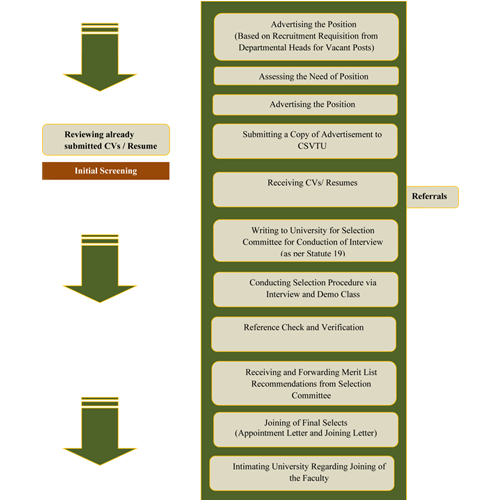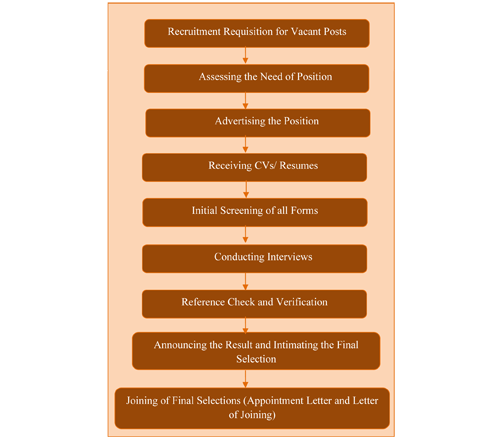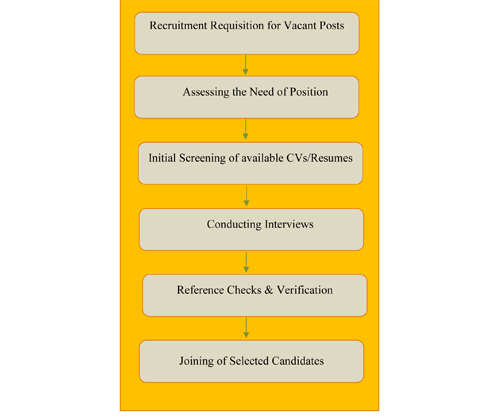This document provides guidelines regarding the appointment of teaching and non-teaching staff at SSIPMT, Raipur:
A. Teaching staff:
B. Non-Teaching:
Effective recruitment and selection procedures are important in attracting and retaining high-quality staff. It is the policy of the institute to recruit high potential that is committed towards the development of the institute. For this, the policies must be fair, rigorous, and transparent. All decisions relating to recruitment and selection must be consistent with the criteria outlined for the post.
For Teaching Position, the criteria are Qualification, experience, achievements, communications skills, professional aspiration, knowledge of and interest in higher education, teamwork, and organizational skills.
For Non-teaching Administrative Positions, the criteria are Qualifications including IT skills, knowledge and experience, administrative skills, interpersonal skills, teamwork, and organizational skills.
For Technician Position, the criteria are Qualification and experience, technical knowledge, interpersonal skills, developmental potential, teamwork, and organizational skills.

1. Recruitment Requisition from Departmental Heads for Vacant Posts: Requirements for Vacancies from various departments are sent to the Principal. The requirement includes job description and specification along with the required number of candidates.
2. Assessing the Need of Position: This includes establishing the purpose of the position to be filled. The institution goals and mission statements are clearly defined and understood before searching for qualified individuals.
3. Advertising the Position: The institute advertises discipline-wise and cadre-wise vacant posts in local as well as one or two national newspapers. One original copy of the advertisement is sent to the university.
4. Submitting a Copy of Advertisement to CSVTU: As per the guidelines received from CSVTU, a copy of the advertisement should be submitted to the University for Display on their website.
5. Receiving CVs/Resumes: All CVs or Resumes are collected by the due date and a primary screening is done. If no application or resume is received for any advertised post(s), the institute shall have to re-advertise for such posts, or else referrals or previously submitted applications are considered. The registrar section ensures that each applicant fits the profile, since a good selection reduces turnover, training and recruitment costs, and thereby produces stability, consistency, and low operating costs.
6. Writing to University for Selection Committee for Conduction of Interview (as per Statute 19): After the initial screening of submitted CVs/Resumes the institute writes to the university for nomination of Selection Committee Members for interviewing the candidates. The norms are followed as per Statute 19.
7. Conducting Selection Procedure via Interview: Once the university shares details of Selection Committee members and dates, the schedule is made and is confirmed with all individuals who will be involved in the interview process. An intimation of schedule is shared with the candidates and the interviewers.
8. Receiving and Forwarding Merit List and Recommendations from the Selection Committee: Recommendations of the Selection Committee in the form of minutes are sent to the university. This includes the cadre-wise and discipline-wise merit list of the applicants. The appointment remains valid from the date of the issue of approval letter from the university or date of joining, whichever is later.
9. Reference Check and Verification: One of the most crucial but often neglected steps in the hiring process is reference checking. A reference check is done for those candidates who have advanced to the final stage and are under serious consideration for the job. It is ensured that the documents about the qualification and teaching experience of candidates are enclosed along with the CV/ Resume for verification at university as well. If the experience letter of any candidate pertains to other universities, the seniority list of that university is made available.
10. Joining of Selected Candidates: Once a qualified candidate has been recommended, the Registrar Section contacts him/her and makes the job offer. Some important issues that are addressed in the job offer are: starting salary, starting date, length of the contract, employee benefits, moving expenses (if applicable), living accommodations (if applicable), or any other points of negotiation. The candidate is given sufficient time to either accept or reject the offer. If the candidate declines the position, the hiring supervisor makes the offer to the next candidate of choice or reconvenes the selection committee to make other arrangements.
11. Intimating University regarding Joining of the Faculty: The joining of the faculty is intimated to the university along with the written contract prescribed in the appendix of statute 19 within one month from the date of joining of the faculty.

1. Recruitment Requisition for Vacant Posts: Vacancy from various departments is sent to the Principal. The requirement includes job description and specification along with the required number of candidates.
2. Assessing the Need of Position: This includes establishing the purpose of the position to be filled.
3. Advertising the Position: The institute advertises for the vacant posts in the local as well as one or two national newspapers
4. Receiving CVs/ Resumes: Throughout the year the candidates visit and submit their CVs/Resumes in the Registrar Section. When the vacancy appears then these forms are reviewed. Also through reference, the database is collected.
5. Reviewing already submitted CVs / Resume/Referrals: Review of referrals and also the prior submitted applications/ resumes are reviewed for the recruitment process.
6. Conducting Interview: Once the applicant pool has been screened and persons are identified, the interview schedule is made and is confirmed with all individuals.
7. Reference Check and Verification: Reference checks are done for the shortlisted candidates. In this, the documents supporting qualification, experience, other skills are checked and verified.
8. Announcing the Result and Intimating the Final Selection: After confirmation of the candidate’s credentials, the list of final selects is made. The selected candidates are informed by the Registrar Section about the same.
9. Joining of Selected Candidate(s): Once candidates are finalized, the Registrar Section makes the job offer with the preferred person. Some important issues that are addressed in the job offer are: starting salary, starting date, employee benefits, etc. If the candidate accepts the position, the offer and conditions of hire are sent to the candidate in writing as soon as possible and if the candidate declines the position, the hiring supervisor makes the offer to the next candidate of choice. All the rules and conditions are communicated to the candidate.

1. Recruitment Requisition for Vacant Posts: Vacancy for various positions is sent to the Principal.
2. Assessing the Need for the Position: This includes establishing the purpose of the position to be filled.
3. Conducting Interview: Around the year the candidates visit and submit their bio-data in the Registrar Section. So when the vacancy appears then these forms are reviewed. Also through reference, the database is collected. Once the Resumes are screened a few candidates are shortlisted for face to face interviews. The schedule is made and communicated to them.
4. Reference Check and Verification: The documents supporting qualifications, work experience, or other skills are checked and verified. For example Drivers, driver’s licenses are checked while hiring for the position of driver. The police verification form is also to be filled for some positions.
5. Joining of a Selected Candidate during Hiring: Once candidates are finalized, the Registrar Section makes the job offer with the preferred person. Some important issues that are addressed in the job offer are: starting salary, starting date, employee benefits, etc. If the candidate accepts the position, the offer and conditions of hire are sent to the candidate in writing as soon as possible and if the candidate declines the position, the hiring supervisor makes the offer to the next candidate of choice. All the rules and conditions are communicated to the candidate.